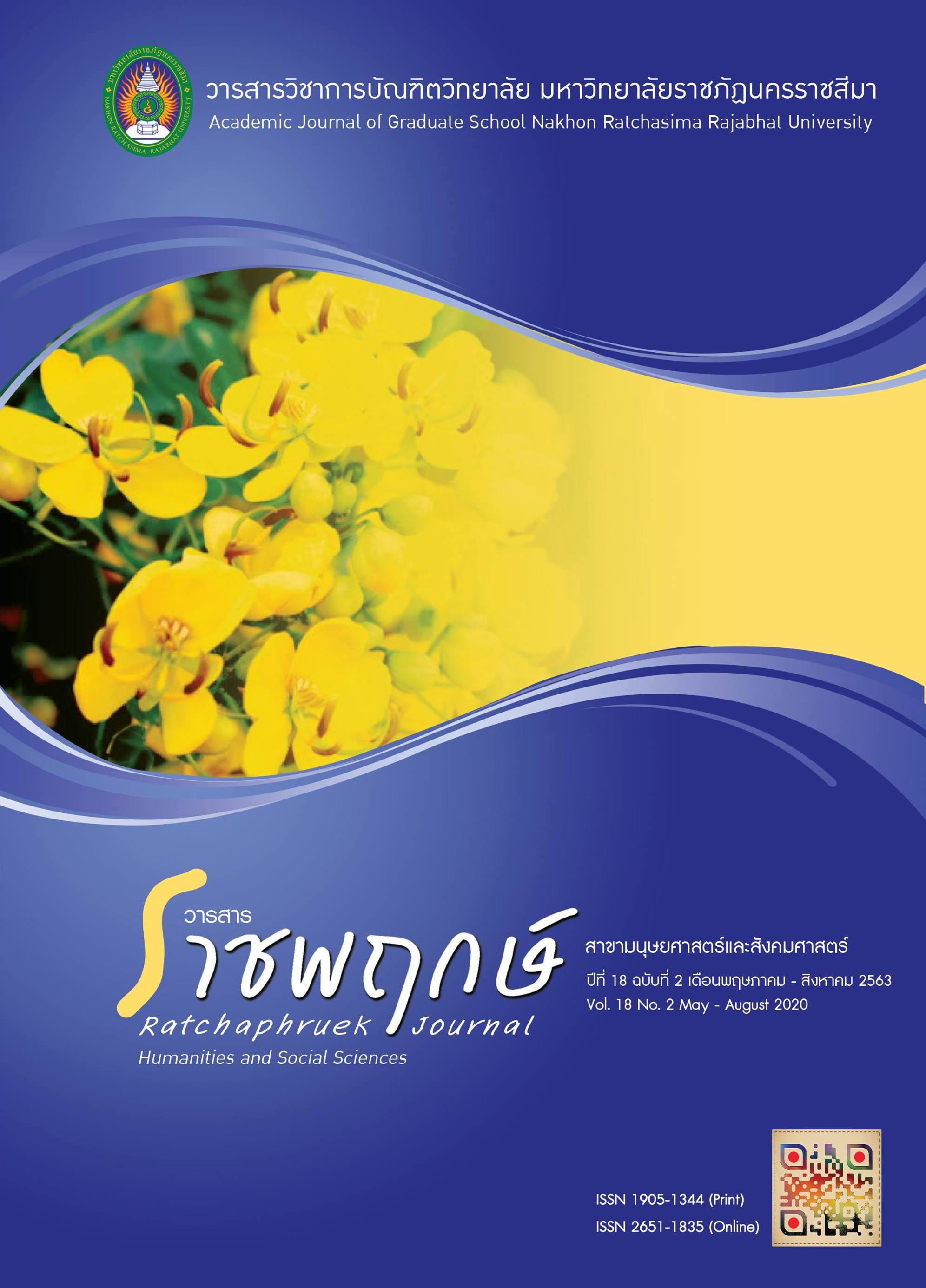A Study of Reading Comprehension Ability and Group Working Behaviors of the Sixth Grade Students by Using CIRC Learning and Mind Mapping
Main Article Content
Abstract
This research was the study of reading comprehension ability and group working behavior by using CIRC learning with mind mapping. It aimed to: 1)compare reading comprehension ability of the grade sixth students before and after, and compare students’ achievement with the designated 70%; and 2) compare group working behaviors before and after the lessons. The sample group of 18 students drawn of the sixth grade students in the second semester, academic year 2018-2019 from Bannhongtakaew School Nakhon Ratchasima Primary Education Service Area Office 4. Research tools were the lesson plans, analysis reading comprehension ability form, and the group working behaviors observation form. Statistics used for data analysis were mean, percentage, standard deviation and t-test (t-test for dependent and t-test for one sample).
The research revealed that 1) The post-test score was higher than pre-test with statistical significance at the .05 level. The analytical post teaching score of the reading comprehension ability of the sixth grade students by using CIRC learning and Mind mapping was higher than 70% by the designated criteria with the statistical significance at the .05 level. The analytical score of group working behaviors with sixth grade students by using CIRC learning and Mind mapping was higher than those before with statistical significance at the .05 level.
Article Details
References
การทำงานร่วมกันของนักเรียนชั้นประถมศึกษาปีที่ 3 โดยการจัดการเรียนรู้แบบ
ร่วมมือ เทคนิค CIRC. (วิทยานิพนธ์มหาบัณฑิต, มหาวิทยาลัยราชภัฏนครราชสีมา).
กิตติพงษ์ ลืมนาม. (2561). วิธีวิทยาการวิจัยทางการศึกษา. นครราชสีมา: โคราชมาร์เก็ตติ้ง
แอนด์ โปรดักชั่น.
ชัยวัฒน์ สุทธิรัตน์. (2552). 80 นวัตกรรมการจัดการเรียนรู้ที่เน้นผู้เรียนเป็นสำคัญ. กรุงเทพฯ:
แดเน็กซ์ อินเตอร์คอร์ปอเรชั่น.
ธนู ทดแทนคุณ และกุลวดี แพทย์พิทักษ์. (2548). ภาษาไทย 1. กรุงเทพฯ: โอเดียนสโตร์.
นฤพร คำศรีแก้ว. (2557). การพัฒนาทักษะการอ่านจับใจความและการเขียนภาษาไทย
โดยการจัดกิจกรรมการเรียนรู้แบบร่วมมือ เทคนิค CIRC สำหรับนักเรียนชนเผ่า
ชั้นประถมศึกษาปีที่ 6. (วิทยานิพนธ์มหาบัณฑิต, มหาวิทยาลัยราชภัฏเชียงราย).
พเยาว์ สิ่งวี. (2551). ผลการจัดการเรียนรู้แบบร่วมมือกลุ่มสาระการเรียนรู้ภาษาไทย
ด้านการอ่านจับใจความ โดยใช้เทคนิค CIRC สำหรับนักเรียนชั้นประถมศึกษาปีที่ 3
โรงเรียนวัดดอนไก่เตี้ย. (วิทยานิพนธ์มหาบัณฑิต, มหาวิทยาลัยราชภัฏเพชรบุรี).
พลศิริ นาควัชระ. (2557). พื้นฐานการใช้ภาษาไทย. ปทุมธานี: มหาวิทยาลัยราชภัฏ
วไลยอลงกรณ์ในพระบรมราชูปถัมภ์.
พันธุ์ทิพา หลาบเลิศบุญ. (2550). ภาษาไทย 3. (พิมพ์ครั้งที่ 4). กรุงเทพ: จุฬาลงกรณ์
มหาวิทยาลัย.
วนิดา อารมณ์เพียร. (2552). การศึกษาผลสัมฤทธิ์ทางการเรียนวิชาคณิตศาสตร์ความคงทน
ในการเรียนรู้ เรื่อง การหารทศนิยม และพฤติกรรมการทำงานกลุ่ม ของนักเรียนชั้น
ประถมศึกษาปีที่ 6 จากการจัดการเรียนรู้โดยใช้เทคนิค STAD และเทคนิค TGT.
(วิทยานิพนธ์มหาบัณฑิต, มหาวิทยาลัยราชภัฏนครราชสีมา).
สุนันทา มั่นเศรษฐวิทย์. (2562). การอ่านจับใจความ. นนทบุรี:มหาวิทยาลัยสุโขทัยธรรมาธิราช.
อัจฉรา พงษ์เย็น. (2556). การพัฒนาทักษะการอ่านจับใจความสำคัญภาษาไทย ของนักเรียน
ชั้นประถมศึกษาปีที่ 3 โดยใช้วิธี ซี ไอ อาร์ ซี. (วิทยานิพนธ์มหาบัณฑิต,
มหาวิทยาลัยเชียงใหม่).
Johnson, R. (1994). Leading the cooperative school. Edina, Minn: Interaction Book.
Slavin, R. E. (1987). Cooperative learning : Theory research and practice. Boston:
Allyn& Bacon.


